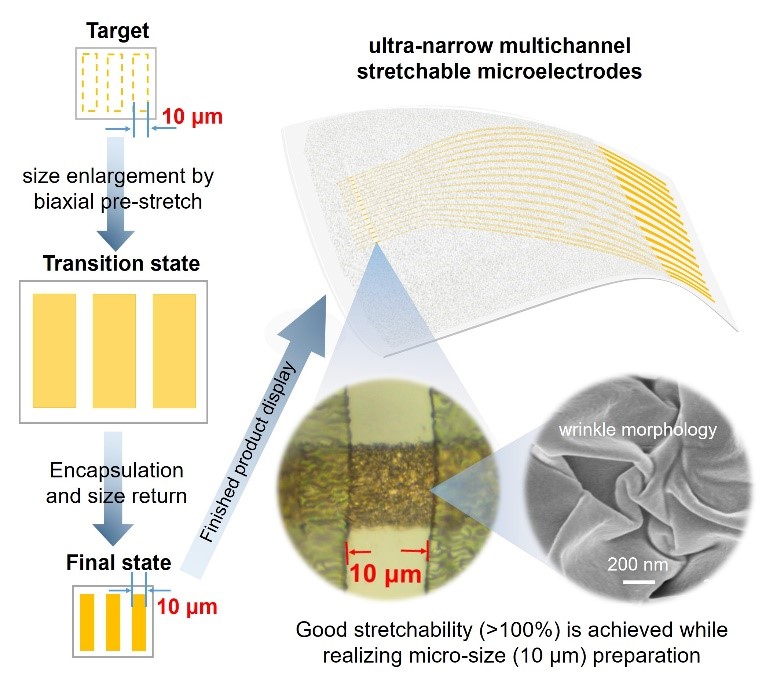A Hybrid Strategy-based Ultra-narrow Stretchable Microelectrodes with Cell-level Resolution
Date:08-09-2023 | 【Print】 【close】
Researchers from the Shenzhen Institute of Advanced Technology (SIAT) of the Chinese Academy of Sciences (CAS) reported a hybrid strategy-based ultra-narrow stretchable microelectrodes with cell-level resolution. They demonstrated that stretchable microelectrodes can detect the electrophysiological signals of single cells in vitro and collect electrophysiological signals more precisely in vivo.
The study was published in Advanced Functional Materials on Jul. 18.
Stretchable ultra-narrow microelectrodes (e.g., 10 μm in width) are essential for electrophysiological monitoring of individual cells, providing a fundamental understanding of how neural networks or other electrically functional cells work.
To achieve single-cell resolution, the size of the monitoring site should be smaller than the target cell, such as a typical nerve cell less than 15 μm or smaller, otherwise a monitoring site may pick up signals from nearby cells without the ability to distinguish. In addition, the target cell or tissue is soft and deformable, and the interface electrode should be soft and stretchable, especially in the case of electrophysiological monitoring in vivo. Therefore, the development of multi-channel stretchable ultra-narrow microelectrodes (such as 10 μm width) is of great significance.
Current preparation strategies are mainly the preparation of ordinary stretchable electrodes with a width of hundreds of microns or millimeters using inorganic conductive materials, or the development of conductive organic polymer gels for ultra-narrow electrodes with low stretchability and long-term implantation instability, so the exploration of ultra-narrow stretchable inorganic electrodes with biological interfaces is still very much worth looking forward to.
The researchers developed a hybrid strategy to fabricate ultra-narrow multichannel stretchable microelectrodes. They investigated the relevant mechanisms and demonstrate that the dependent methods in this strategy are synergistic and indispensable for achieving electrode stretchability.
Stretchable inorganic electrode arrays with widths as low as 10 μm have been prepared without the use of lithography or laser-assisted etching. A 10 μm × 10 μm monitoring window with enhanced interface impedance was prepared by using a special rough surface. The stretchability of the 10 μm wide stretchable electrode reaches 120%. The array has a density of sensing points up to 8/0.003 mm2, and the coarse morphology of the electrodes provided by this hybrid strategy is largely conducive to the interface impedance of the electrodes. The prepared ultra-narrow stretchable microelectrode has good fatigue resistance and cycle stability.
This preparation strategy will facilitate the preparation of thin stretchable microelectrodes. This will significantly improve the monitoring and stimulation resolution of inorganic stretchable electrodes.

Conceptual scheme of the proposed hybrid strategy to prepare multi-channel ultra-narrow stretchable inorganic electrodes and the core performance achievement. (Image by SIAT)
Media Contact:
ZHANG Xiaomin
Email:xm.zhang@siat.ac.cn